Posts Tagged ‘veterinary care’
Kennel Cough: What You Need To Know
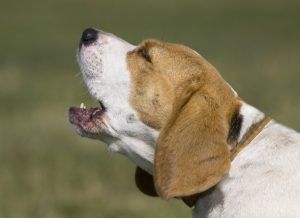 Doggy daycare, like regular daycare, can be a cesspool of different germs and infections. If your dog comes home from daycare with a strange cough, your dog might have contracted kennel cough. Kennel cough can be caused by a variety of different viruses and bacteria. Kennel cough is caused by a dog inhaling bacteria or viruses into their upper respiratory tract. Symptoms can be worsened if their lungs are already overworked by cold air, cigarette smoke, stress, or crowded quarters with poor ventilation.
Doggy daycare, like regular daycare, can be a cesspool of different germs and infections. If your dog comes home from daycare with a strange cough, your dog might have contracted kennel cough. Kennel cough can be caused by a variety of different viruses and bacteria. Kennel cough is caused by a dog inhaling bacteria or viruses into their upper respiratory tract. Symptoms can be worsened if their lungs are already overworked by cold air, cigarette smoke, stress, or crowded quarters with poor ventilation.
The respiratory tract is usually lined with mucus which helps trap particles that might cause infections which is why kennel cough is often caused by multiple different pathogens – one weakens the mucus in the lungs allowing the other to take root and cause infection. Kennel cough is extremely contagious and spreads around the environment where other dogs inhale the pathogen and become sick. Kennel cough is difficult to control since it is airborne. The main symptom of kennel cough is a cough that sounds like a goose honk. Some dogs will only experience coughing with kennel cough while others may have other symptoms such as sneezing, a runny nose, or eye discharge.
Severe symptoms may include retching, lethargy, and fever. Usually kennel cough lasts for three to four weeks with the worst symptoms in the first five days and dwindling over time. Young puppies and older dogs with weakened immune systems are more susceptible to kennel cough and can take up to six weeks to recover. Stress and environmental factors like temperature, dry climate, and airborne irritants like smoke can increase the severity of prevalent symptoms.
Vaccines for kennel cough are extremely important as they can reduce the odds of getting it or reduce the symptoms. While the vaccine is not 100% effective, it can greatly reduce the odds of your dog contracting the illness if they is frequently in conditions that tend to spread the disease, such as daycare. The vaccine is typically offered in oral, intranasal, and injected forms. The biggest mistake believed by some is that kennel cough is a minor issue that doesn’t call for a trip to the vet. While it may seem like a minor problem, kennel cough can lead to pneumonia or death, especially in dogs that already have weakened immune system.
It’s better to be safe than sorry and take your dog to the vet at the first signs of kennel cough, rather than waiting for the issue to progress. Your vet will be able to tell you how severe of a treatment needed to help your pets kennel cough. A mild cough may only need rest and a cough suppressant while severe kennel cough may require antibiotics or supportive care. Coughing is not only indicative of kennel cough; it may also indicate major health issues such as a collapsing trachea, canine distemper, canine influenza, bronchitis, asthma, or even heart disease. It is always best to err on the side of caution and bring your dog to the vet at any sign of coughing.
There are several home remedies that may help soothe your pet’s symptoms and reduce discomfort. Create a humid environment by using a humidifier or turning on a hot shower and putting your dog in the bathroom with the steam. Some dog owners have found that a small amount of honey daily can help a dog’s throat. Honey has natural antimicrobial and anti fungal agents that can reduce inflammation and soothe sore throats. Thus, reducing coughing while helping your pup fight off infection. Simply give your dog a spoonful of raw honey a few times a day. As always, be sure to check with your vet before introducing human food into your dog’s diet. Another option to consider is CBD oil. It is natural found in hemp plants and highly regarded for its health benefits. The anti-inflammatory properties of CBD oil can ease pain and swelling, restoring comfort.
Kennel cough is not a common cold. It is best to visit your veterinarian right away to learn of the best treatment path. As always, feel free to contact Dr. Olsen at 618-656-5868 with any questions or to set up an appointment.
Dr. Olsen’s Breed Spotlight: The Peruvian Inca Orchid
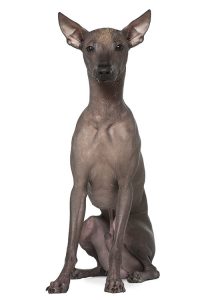 The Peruvian Inca Orchid is not a flower, but a hairless sighthound that developed in Peru. The breed can be hairless or coated and can be found in a range of sizes. These dogs are good hunters and do well in agility. In the hairless variety, the skin can be of any color. The coated variety features all colors as well including black, brown, pink, tan, and white. On a sunny day, Peruvian Inca Orchids require sunscreen because of their exposed skin.
The Peruvian Inca Orchid is not a flower, but a hairless sighthound that developed in Peru. The breed can be hairless or coated and can be found in a range of sizes. These dogs are good hunters and do well in agility. In the hairless variety, the skin can be of any color. The coated variety features all colors as well including black, brown, pink, tan, and white. On a sunny day, Peruvian Inca Orchids require sunscreen because of their exposed skin.
The ancient history of the Peruvian Inca Orchid can be told through pottery and textiles. The breed first appeared in Moche pottery in 750 AD. The Chancay people used the dogs as companions, and certain pottery even depicts them in sweaters. The Chimu considered them good luck and used the dogs’ warmth for the treatment of arthritis and respiratory conditions.
The original hairless dogs were small companion animals, but when Peru was conquered by the Conquistadors, the small dogs were interbred with the dogs of the foreigners and over the years, three distinct sizes developed. In the mountainous regions, the Andean people protected the dogs, but the breed did not fare well in the cities along the coast. There, the hairless dogs were considered diseased and were often exterminated.
In 1966, an American, Jack Walklin, visited Peru and brought eight dogs back to the US. He is believed to be the one to have named the breed the Peruvian Inca Orchid and the breed was established under that name in the US and Europe. In 2001, Peru declared the breed a National Patrimony and the dogs are now protected in Peru.
Peruvian Inca Orchids come in a range of sizes with the smallest standing just short of 10” and the largest topping out at 26”. The distinguishing feature of a Peruvian Inca Orchid is their hairlessness. Their skin can be a solid color or spotted with unpigmented areas. Peruvian Inca Orchids that are coated are in the minority and can occur in the same litter with hairless Peruvian Inca Orchids.
Peruvian Inca Orchids are slim dogs who are very noble and affectionate to those close to them. At the same time, Peruvian Inca Orchids are lively, alert, and can be wary of strangers. Peruvian Inca Orchids make good watch dogs. Peruvian Inca Orchids are loyal and protective of their family but like all dogs should be supervised around children. If you have small pets, the Peruvian Inca Orchid might not be the dog for you as Peruvian Inca Orchids might mistake your small pet as prey.
What To Do If Your Dog Gets Into A Fight With Another Dog
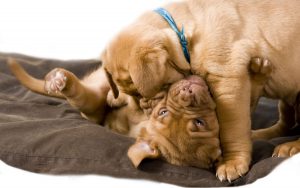 Dogs often wrestle and playfully bite each other. It’s just part of puppy play time. Sometimes, the wrestling turns into a full-blown dogfight. If the fight doesn’t seem to show signs of stopping, it’s important to step in before one of the dogs get hurt.
Dogs often wrestle and playfully bite each other. It’s just part of puppy play time. Sometimes, the wrestling turns into a full-blown dogfight. If the fight doesn’t seem to show signs of stopping, it’s important to step in before one of the dogs get hurt.
Most dogfights only last for a few seconds. It’s important to stay calm and clear headed. Resist the urge to grab your dog by the collar. It might be your first impulse, but when dogs are really fighting, they may whip around and instinctively bite your hand without any past aggression. You are able to tell that it’s a real dogfight when the dog’s bodies are rigid. To stop the fight, make as much noise as possible. You can yell, shriek, stomp your feet, clap your hands, etc. Do whatever you can to attract the dogs’ attention. Similarly, you can use water to get their attention. You can douse the dogs with a hose, bucket of water, etc. (If you are going to a new dog park or unfamiliar place, bring a spray bottle just in case a fight breaks out.) You can also use a barrier such as a large piece of cardboard, plywood, even a big stick to split them up. The large barrier acts as a way to split them up without risking your hands. Lastly, you can throw a blanket over the dogs. Some dogs will stop fighting when they can’t see each other anymore.
It’s important to know when you should step in. Scuffles between dogs last only a few seconds and can appear worse than they actually are. Fights involving fighting breeds should be stopped as they have trouble reacting to social signals from other dogs. Fights between dogs of two very different sizes or two females in heat will need to be broken up; as well as fights involving dogs who are known to have done physical harm in the past or will not walk away. Under no circumstances should you get between the two dogs. You can grab your dog from behind and grab the top of its hind legs, so it is in a wheelbarrow position. You can then walk backwards circling to one side so the dog will not be able to turn and bite you. After you stop the fight, be sure to separate the dogs and keep them out of each other’s sight. This prevents the chance that the two dogs may start fighting again.
To ensure that fight never happens, observe how your dog interacts with other dogs. Does your dog bark, pounce, and snap at other dogs? Do they play rough normally? If you know how your dog acts normally, you will be able to know when a fight is getting ready to begin. When dogs play, it often sounds a lot like it does when they’re fighting. Dogs will growl, snap their jaws, and bite one another roughly. Instead of listening, watch the dogs’ bodies. If they look loose and relaxed, and they’re wagging their tails, they’re probably just playing. However, if the dogs’ bodies appear stiff and rigid, and their tails are down, they may get ready to fight. If one dog thinks it is play time and the other isn’t seeing it as fun, it is best to separate them to avoid any fighting. To further prevent fighting, don’t encourage competition. Dogs get territorial over food and toys. Some breeds are more apt to defend their rights to beloved possessions while some are more apt at sharing. Be sure to know your dog’s unique personality traits so that they can prevent a battle from happening when another dog comes around. You can put treats, food, and toys away when your dog is having social time with another dogs and feed multiple dogs in separate rooms.
Preventing fights start from when the dogs are young puppies. Teach them to play nicely. Use positive reinforcement to reward good behavior. When your dog bites, growls, or exhibits other violent behavior, separate them from the dog that they are playing with and put them in time out until she calms down. Similarly, make sure that your dog knows to come when they are called. If your dog is good at obeying your call to come, you’ll be able to pull them out of tense situations before a fight may start.
As always, feel free to contact Dr. Olsen at Olsen Veterinary Clinic by calling 618-656-5868.
Dry Drowning: What Is It And How Do I Prevent It For My Dog
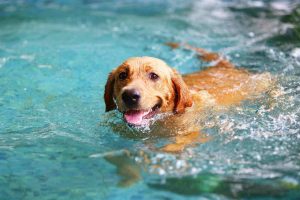 Everyone knows of drowning when a person or a pet is submerged in water and can’t get oxygen. Have you heard of dry drowning? Dry drowning occurs when water is aspirated into the lungs or other parts of the airway. If the water doesn’t make it to the lungs, the vocal cords can begin to spasm making breathing difficult. If water does make its way to the lungs, serious complications and even death may occur. The latter condition is referred to “secondary drowning”, but it’s usually also referred to as dry drowning. Dry drowning is a scary thing as it can ‘happen’ HOURS after exposure to water. It’s something that affects all animals with exposure to water, from humans to dogs.
Everyone knows of drowning when a person or a pet is submerged in water and can’t get oxygen. Have you heard of dry drowning? Dry drowning occurs when water is aspirated into the lungs or other parts of the airway. If the water doesn’t make it to the lungs, the vocal cords can begin to spasm making breathing difficult. If water does make its way to the lungs, serious complications and even death may occur. The latter condition is referred to “secondary drowning”, but it’s usually also referred to as dry drowning. Dry drowning is a scary thing as it can ‘happen’ HOURS after exposure to water. It’s something that affects all animals with exposure to water, from humans to dogs.
How does dry drowning happen? It can be brought on by a dramatic water event or just a typical bath. A dog whose head goes under the bathwater is just as susceptible as a dog who actively jumps into the pool. In a lot of cases, dry drowning doesn’t look like much at all as the condition starts to shape.
Dry drowning is caused by swallowing water. That’s it! For a moment, consider how large your dog’s mouth is and imagine what it feels like when you go underwater unprepared. The natural instinct is to gasp for air, and it is unavoidable. If your dog has the same instinct, your dog could swallow a lot of water in just one gulp.
If water has gotten into your dog’s lungs, it could take hours or in some cases even days for signs to show. The most common symptoms include coughing or hacking, signs of chest pain, difficulty breathing or wheezing, and extreme lethargy. If you suspect your dog may be suffering from dry drowning, take your dog to the vet immediately. Even if your dog doesn’t seem to be in duress, it’s best to have your dog checked out just to be sure.
It’s important to note that dry drowning can happen as a result of swallowing sand as well. A dog who respirates a lot of sand can suffer the same ill effects of secondary water drowning and should be checked out by a vet.
To protect your dog from dry drowning, be sure to monitory your dog closely around water. Even if your dog is a prolific swimmer, you want to keep an eye on your dog to make sure that a swallowing episode doesn’t occur. It only takes one swallow to dry drown. If your dog is around water frequently, invest in a fitted life jacket to ensure that your dog’s head stays above water as much as possible. HERE is an article from the American Kennel Club listing multiple safe options. Even though most dogs can doggie paddle, their arms get tired just like ours do. Lastly, always take “near” drowning seriously. Even though dogs have a natural swim instinct, if you ever have to “rescue” your dog from the water you should watch her closely for several days afterwards to look for signs of secondary drowning.
As always, if you have any questions or wish to make an appointment, contact Dr. Olsen at Olsen Veterinary Clinic or call us at 618-656-5868.
How To Protect Your Pet From The Heat
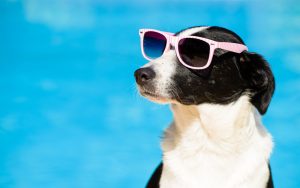 Protecting your pet from the heat is extremely important. As temperatures rise, it becomes more and more uncomfortable to be outside. This is true for your dog as well. During the summer, it is healthier for your dog if you limit outside time, time in dog parks, and exercise to cooler parts of the day, such as morning and evening times. It is not always the temperature as well. The humidity can cause your dog to have difficulty panting. Panting helps your dog cool itself off. Without being able to pant, your dog’s temperature can rise that can lead to heatstroke. If your dog is exhibiting any of the signs of overheating (heavy panting, heavy drooling, trouble breathing, rapid heartbeat, dark or red gums and tongue, dizziness, and weakness, or agitation), be sure to bring your dog to the vet right away. To avoid overheating, there are multiple things that you can do to keep your puppy cool during the hot summer.
Protecting your pet from the heat is extremely important. As temperatures rise, it becomes more and more uncomfortable to be outside. This is true for your dog as well. During the summer, it is healthier for your dog if you limit outside time, time in dog parks, and exercise to cooler parts of the day, such as morning and evening times. It is not always the temperature as well. The humidity can cause your dog to have difficulty panting. Panting helps your dog cool itself off. Without being able to pant, your dog’s temperature can rise that can lead to heatstroke. If your dog is exhibiting any of the signs of overheating (heavy panting, heavy drooling, trouble breathing, rapid heartbeat, dark or red gums and tongue, dizziness, and weakness, or agitation), be sure to bring your dog to the vet right away. To avoid overheating, there are multiple things that you can do to keep your puppy cool during the hot summer.
To begin, make sure to keep your dog groomed, especially if they have long fur. Each breed has different needs. For example, dogs with short, thin coats handle heat better than cold weather and mountain dogs. No dog is immune to heatstroke or paw pad burns, so it’s important to keep your dog groomed. If you get any mats and tangles out of their fur, it will help keep them cool. However, don’t shave or clip their coat until you talk to your vet or groomer. The extra fur that helps your dog stay warm in the winter may also keep it cool in the summer. To keep your dog’s paw pads safe, stick to shaded areas or bring insulation booties to protect your dog’s feet from the hot pavement. To test the heat of the pavement, feel it with the back of your hand. If it is too hot for you, then it is definitely too hot for your dog.
Similarly, be sure to keep your dog’s shots up to date, especially in the summer. The parvovirus spreads in hot weather. During the summer, your dog probably spends more time outside which means that it could come in contact with an animal that has rabies. Summer is also a high season for fleas and mosquitos, both which carry many diseases. By giving your dog medication to prevent these pests, your dog will be safer in the long run.
This should go without saying but leave your pet at home unless your destination is pet friendly. Do not leave your pet in your car. Even with the windows of your car cracked, the temperature inside the car rises rapidly in the summer heat. Similarly, keep your dog’s water supply full. Be sure that there are multiple bowls available for your dog that are always filled with fresh water that is clean. Even if you think that the walk you are going on will be short, be sure to bring clean drinking water and a dish that your dog can easily drink from. If you are worried that your pet is not drinking enough water, add some ice cubes to the bowl. It will make drinking water more appealing to dogs.
When you are spending days outside by a pool or a lake, you can do many things to keep your dog cool while you enjoy the summer sun. You can freeze containers of water so that they will stay cooler for longer. Be sure to keep their water in the shade. You can also provide a small kiddie pool or a sprinkler for your dog to play in. These allow fun places for your dog to cool off and maybe even get some exercise. Similarly, you could put a pet-friendly dig area for your dog in your yard. These can include a sandbox area that your dogs are able to dig in. Dogs often dig a hole to sit in and keep cool. To make an even cooler area, you can spray sand with your cold water. Be sure to make sure that it is located in the shade and not in the sun.
Sometimes, a little extra help is needed to cool your dog. Dog cooling mats and cooling vests are great products. Many work by soaking them in cool water for a long time. If you don’t have access to these, you can soak a towel in cool water and let your dog lie on it. You can also spray your dog’s belly and paws to cool them down. Dogs will cool down more quickly through their belly and paws than water sprayed on their back. Another great DIY to keep your dog cool is to put a pan of ice water in front of the fan to make it more effective for your pup to stay cool.
There are many similar DIYs to keep your pet cool in the summer. Dog-Safe ice cream exists, and you can make it at home. Here is a big list of easy to make ice creams that won’t cost an arm and a leg unlike the gourmet pet store ice-creams. You can also make some frozen treats to put in your dog’s favorite toy. Kong toys come in all shapes and sizes because all dogs love them. They are tough rubber chew toys that are meant to be filled with yummy sticky treats like peanut butter to keep your dog occupied for a while. There are pet-friendly recipes available that are meant to be frozen to keep your dog refreshed while they lick the center. Similar to the Kong treats, you can freeze your dog’s favorite treats in a popsicle mold and fill it with water. It will give your dog a fun treat to keep them cold.
The summer gives many fun opportunities for you and your family. You wouldn’t allow a member of your family to overheat, so don’t let your dog (a furry family member). By following the simple rules of pet care and making some fun treats that your dog will enjoy, you and your dog can have a healthy and cool summer! Make sure to contact our office if you have any questions!
You CAN Teach An Old Dog New Tricks!
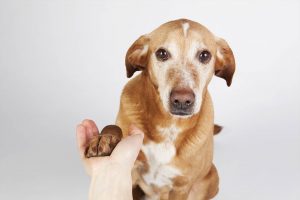 We have all heard the saying, “You can’t teach an old dog new tricks.” Not true! Yes, you can!
We have all heard the saying, “You can’t teach an old dog new tricks.” Not true! Yes, you can!
Most people associate training with young puppies, but the reality is that dogs are able to learn at any age. Surprisingly, adult dogs are often easier to train than younger puppies because they have more self-control. Whether you just adopted an adult dog, or your older pet needs to learn some new tricks, training offers mental stimulation and keeps your dog’s mind sharp. It is important that you be patient when training both adult dogs and puppies. If you have just brought an adult dog to your home, allow the dog time to adjust. Adult dogs have their own histories that may make them nervous about new surroundings. Don’t give up on the dog after only a few days. Adult dogs may need a period of adjustment which can take anywhere from a few days up to a month. Once the dog realizes that they have found their forever home, it will soon settle into being a part of the family.
Similar to housetraining a puppy, you should use a crate when housetraining an adult dog. You cannot assume that an adult dog is housetrained so you should keep it in a crate when you are not able to supervise it. When you release your dog from the crate, take your dog immediately to the place outside where you want your dog to relieve himself. If it does not relieve itself, re-crate your dog and try again later. Be sure that your crate is large enough and strong enough for your dog to fit comfortably. Your dog should be able to stand up, move around, and stretch out without difficulty. Soft-sided crates are often too flimsy to stand up to the needs of an adult dog so the best option is usually a metal crate that can be folded for easy transportation. Be sure to provide your crated dog with water, soft blankets, and chew toys as well as enough attention, exercise, and outdoor time so your dog can relieve itself.
If your dog is new to crates, introduce the concept slowly. Entice your dog to enter the crate by offering food and keep it in the crate for only a few minutes at first. Be sure to avoid using the crate as a form of punishment or leaving your dog isolated in its crate for long periods. The housetraining process usually goes by quicker for older dogs as they have more control over their bladders and bowels than young puppies do.
Whether you just brought your adult dog home, or your adult dog needs some training, an obedience class is a great place to do it. Obedience classes allows you and your dog to learn basic commands, such as lying down and walking on a loose leash. Even if your dog has never had any obedience training in the past, your adult dog will benefit from the class. Obedience classes also allow your dog to socialize with other dogs and people. You will be able to see how it reacts to other dogs and strangers and gives you the comfort of having a safe environment and a professional dog trainer on stand-by to offer advice.
If you bring an adult dog into your home, they may do things that they were allowed to do in their previous home that you do not want them to do in your home such as jumping on guests or lying on the furniture. To help your dog learn the rules of your house and more importantly, retrain them, be sure to start teaching the rules to your adult dog as soon as possible. The “Nothing in Life is Free” (NILF) dog training method is an effective way to teach your dog self-control. It requires that your dog behave appropriately before getting a desired treat, walk, or positive attention. Lastly, it is important that everyone in the household is on the same page. When different members of the family have different expectations on behavior, commands, and expectations, it can be confusing for the dog. When everyone agrees on appropriate behaviors and uses the same commands and rewards, your dog will learn faster and retain the training longer.
Most often, new owners of adult dogs do not know the experiences that the dog has had with training in the past. Positive reinforcement methods are the best bet for training. Using treats and plenty of praise is an effective method for training dogs of all ages and breeds. Keep things fun and upbeat instead of punishing your adult dog. It is a great way to strengthen the bond between you and your dog. It may take some work at the beginning, but teaching your dog the basic commands and working on solving behavior problems from day one means that your dog will soon settle into being a happy and healthy part of your home.
We are here to help you regardless of the age of your pet. If you have any questions, do not hesitate to contact our office!
Tips For Welcoming A New Puppy Into Your Family
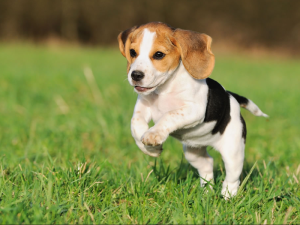 After three years of having a dog-less house with the passing of our beloved Chocolate Lab Ruby, the Olsens are getting a new puppy. Part of me is still in denial, and part of me is apprehensive as to what we need to do to prepare for a new puppy, which is something that we had not had to do in about 13 years. So now that the purchase is done, it is time to ready the home for our newest member, prepare the prior residents (our cats) for invasion of another four-legged friend, and purchase the supplies and equipment needed for the puppy.
After three years of having a dog-less house with the passing of our beloved Chocolate Lab Ruby, the Olsens are getting a new puppy. Part of me is still in denial, and part of me is apprehensive as to what we need to do to prepare for a new puppy, which is something that we had not had to do in about 13 years. So now that the purchase is done, it is time to ready the home for our newest member, prepare the prior residents (our cats) for invasion of another four-legged friend, and purchase the supplies and equipment needed for the puppy.
Preparing the Home
We all know that puppies get into everything. So we will need to act like a forensic detective and get down on our hands and knees to look for things that a playful puppy might foresee as fun. Items like electrical cords should be tied out of reach. Dangerous products such as cleaning supplies and other items should be locked in a cabinet or placed out of reach. Any valuable items or family heirlooms need to be kept out of reach so they do not become your puppies new chew toy. Lastly, unless you want to be like Imelda Marcos and purchase a new pair of shoes each week, it is best to make sure your shoes are stored away in a closet and the door is secured.
Puppies are always looking for their next meal, so garbage can be enticing to them. In order to prevent them getting into the trash, it is wise to have trash cans that have sealed lids.
The puppy should not have free reign of the house, so you will need to have gates and barriers to keep him in his allowed space. This will also include a kennel for his nighttime bed, which I will talk about later in the article.
No puppy will be an entirely indoor dog unless it is in a big city with little green space. So here in Madison County, Illinois, we will want to examine the outdoor area so that there are not any chemicals or poisonous plants that will entice the inquisitive puppy. Your new puppy may be the cutest thing that you have ever seen, but your neighbor may not have the same opinion. And they always say that a good fence makes good neighbors. So it may be important to make sure that you have one that doesn’t allow your pet to roam free.
Items to Have
As I eluded in the last section, in my opinion, it is best to kennel train your pet. No, this is not seen as “doggie jail” to the pet, but as I explain to my clients, it is best to treat a kennel as it is their bedroom and their place of security. I recommend that you get a larger one as they get larger. It should start as one that is just big enough for them to sleep in. If it is too large, that will allow them to urinate and defecate in the kennel and may inhibit the potty training outside.
I am not an advocate for “potty pads.” I feel that they are just condoning bad behavior by the puppy. The learning puppy will get confused by our laziness that more or less tells it that “they can go here but not there in the house.” To a puppy, this thinking may be problematic.
Obviously we want food bowls as well as toys to keep it occupied when you can’t give it the attention it needs. With the toys, I recommend that they be they type that are indestructible like “Kong toys.” Avoid those that they can easily chew up and have the possibility of ingesting.
A new owner will want to have a collar and a leash. When you take your pet out on walks, it will be necessary to have these to protect your pet from injury by other pets or getting ran over by a vehicle.
Grooming brushes are important to have especially with those puppies that will have long wooly coats. They will need to be brushed frequently to prevent matting and tangling.
I am not a big proponent of treats, but they would be alright to have on hand, but I caution the owner to use them in moderation.
Bringing it Home
The big day to bring the puppy into your household is here, so what should you do?
Many people erroneously allow their new puppy to roam free and explore the house. This is sensory overload. Too many new places, new smells and people at once may confuse him. Instead, let him explore a designated area, perhaps where his food and water are. Or he can acclimate himself to a small puppy-proofed space where his kennel is. Then introduce him to the rest of the house one room at a time, skipping the areas that you want off-limits to him.
It is best to introduce your new puppy to its’ new owners one at a time. I know that they are cute and cuddly, and everyone wants to meet him, but that can create too much excitement for the puppy and may stress the puppy out. So it is best to let him meet each family member quietly and make it rewarding and pleasant.
As previously mentioned, puppies love to chew, so make sure that he has a safe chew toy. If he starts to chew on anything else, redirect him to the chew toy.
It is important that your new puppy know where its’ sleeping quarters are. Puppies sleep between 15-20 hours a day, and likely they will drop in their tracks. It is important to take him to his crate when he seems to be ready to nap and at bedtime. Contrary to what most people think, this is not “doggie jail” as the puppy will associate this as a safe and secure place.
House training starts on day one. Your puppy needs to know exactly where you expect him to do his business. Prevent accidents by monitoring the puppy and take him outside accordingly. This helps him to learn where not to go. Accidents happen, but don’t scold the puppy. Clean up the accident with an enzymatic cleaner.
Teaching your new puppy basic behaviors like watch me, sit, or down are important. With positive reinforcement based training, you can encourage good manners in very young puppies.
Obedience training for your new puppy is always important. It will teach basic manners that can lead to all kinds of fun dog activities and provide socialization with other dogs and humans.
In a few weeks, I will be reliving the excitement that our family experienced 13 years ago. Getting a new puppy can be an exciting and stressful time in any household. It teaches our children to be responsible and committed. So if you need advice or any tips in preparing for the new family member, please do not hesitate to contact or call the Olsen Veterinary Clinic at 618-656-5868.
Dr. Olsen’s Breed Spotlight: The Lowchen
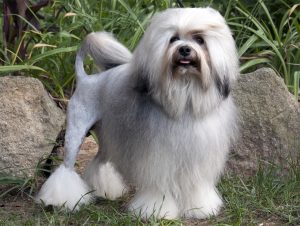 The month of February is reserved to spotlight a dog breed. Most of the time, I try to shed some light on a breed that isn’t very popular. Well this month is no exception as I am featuring a dog that is not very popular, unique in its appearance, rich in history and really considers its only job as being a companion for its owner. That breed is the Lowchen, which is also known as the “Little Lion Dog”.
The month of February is reserved to spotlight a dog breed. Most of the time, I try to shed some light on a breed that isn’t very popular. Well this month is no exception as I am featuring a dog that is not very popular, unique in its appearance, rich in history and really considers its only job as being a companion for its owner. That breed is the Lowchen, which is also known as the “Little Lion Dog”.
The Lowchen is a small breed that generally stands about a foot tall but has an enormous heart. The coat is traditionally kept in a “lion clip” in which most of the hind quarters and tail are clipped down close to the skin. The overall effect is that of a mini lion with a full mane and plumed tail. This breed coat comes in many colors and color combinations.
The breed has a long and somewhat controversial history. We know from works of art depicting images of small dogs in a very distinctive lion trim from the breed dated to the 16thcentury. The breed has been depicted throughout the centuries in paintings, drawings and tapestries from around the world.
The controversy arises as to the exact origin of the breed. There are several theories of debate with one thinking that the breed originated in Northern Europe which is now known as Germany, France and Belgium. Because it came from this area, the Lowchen is thought to be tied to the breeds that were the forerunner to the modern day poodle. The stories go that they were a favorite companion for the ladies of the castles and they would lay close to their owners at night to keep them warm like a water bottle, as well as attract the fleas away from the owner.
Another theory is that the Lowchen originated in the Mediterranean region and are directly related to the Bichon breeds. Also there are some theories that the breed might have originated in Russia or Tibet.
The Lowchen has been a resident of all households through the ages, from castles to farmyards and cottages. Aside from the function of being a companion, they possibly were varmint hunters and fierce little guards.
There is a story from the late 1700’s about a Lowchen whose name was Bijou. As the story goes, Bijou was so upset that his owner was leaving him behind, he jumped out of a castle window into the Lahn River that was 60 feet below. One ending has him surviving and was rewarded by riding to the hunt in the owner’s saddle, the other that the jump ended in disaster. Whichever the outcome, his portrait from 1787 still hangs in the Baronesses’ bedroom in Wellburg Castle.
Little has been written about this breeds early years. The first record of a breeder and fancier was Dr. Walthier in Germany in the 1800’s. The breed standard was written in the 1800’s and in 1897, a Madame Madelaine Bennert purchased her first Lowchen. She is the one who would be recognized for her efforts in saving the disappearing breed.
In 1999, the Lowchen was admitted into the AKC in the Non-Sporting group. The Lowchen is a small breed that weighs about 15 pounds and has a life expectancy or about 13-15 years. It is a very loving dog whose sole purpose is giving love and hoping to get loved in return. It might see a squirrel, chase it and catch it, but it would not know what to do with it if it did catch it. It will bark at strangers, but then when they enter, the Lowchen will lick them to death. The Lowchen’s favorite spot to be is on the couch watching out the window.
Don’t mistake the breeds sweetness, because it is a true lion that will stand up to any German Shepherd and bark down a Great Dane. They are active, smart, and love children. They can make very good agility dogs because they are trainable, resourceful and very adaptable. Since they like to bark, it is recommended that they undergo some obedience training. Due to their haircoat it is advisable that they be brushed regularly and see an experienced groomer monthly. Another plus with this breed is that they are hypoallergenic.
There are very few health problems with this breed. But they may suffer from patellar luxations, heart issues and some eye issues.
Here at the Olsen Veterinary Clinic, we love to see all breeds. So if you have a Lowchen, or a mixed breed, gives us a call at (618)-656-5868 and we will be happy to assist you.
How Often Should I Bathe My Dog?
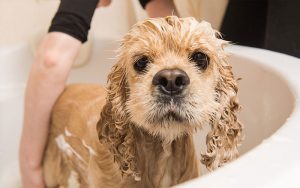 We as humans bathe at least once daily. Right? So should pets get bathed daily also? This is one of the questions that we get from pet owners regarding their four-legged family member. Generally my answer to the question would be no, but there are many factors that go into determining the proper frequency.
We as humans bathe at least once daily. Right? So should pets get bathed daily also? This is one of the questions that we get from pet owners regarding their four-legged family member. Generally my answer to the question would be no, but there are many factors that go into determining the proper frequency.
Obviously if your pet has been running and playing outside a lot and they are dirty and very odorous, then they possibly should be bathed. But why do we even bathe our pets? The easy answer is for its health. Without one, your dogs’ skin could get irritated and infected and its coat could get matted and hard. A dog’s breed, coat characteristics, and other variables play a factor in this.
So how often do we bathe a dog? The top reason is when the smell. Easy rule of thumb is if it smells beyond just normal dog smell, it’s time for a bath. If you are unsure about the skin, I would recommend talking to experts in the field like your veterinarian or a professional groomer. They can help you understand what may be the best options for your pet.
If your pet has skin issues, it may be prescribed a medical shampoo. As a dermatological professor told us—if it is wet, you want to dry it and if it is dry you will want to add moisture. Unfortunately, there is not one shampoo that will do both.
As human’s have different hair and skin issues, so do dogs. Some breeds are double-coated breeds. These breeds like the Samoyed, Alaskan Malamute and the Chow Chow most likely will require less frequent bathing but more brushing to keep their coats healthy and clean. By contrast, a breed like the Bassett Hound has a more oily coat, so it may require more frequent bathings. Short haired breeds like Dalmatians and Weimaraners tend to require very few bathings as they can regulate their natural oils without much help.
Now that we have determined factors that play into bathing your pet, what do we buy? First you will need a shampoo that will be appropriate for your pet as we have discussed previously. Secondly, some lukewarm water. Hot water can burn your pets skin and dry it out. Rule of thumb– the cooler the better. A good brush is good to have on hand. Prior to bathing it is best to comb out your pet and shed any dead hair. By combing agains the coat, you can prevent mats and help spread out your pet’s natural oils. Be sure that you have towels on hand to wipe them dry. I do not recommend using a blow dryer as the heat will dry out the skin. There are also dry shampoos out there that you can use to spray them down with and wipe it off without having to bathe them to preserve the natural oils.
So you are still confused about bathing your pet? Remember that we are always here to assist you, so please don’t hesitate to call us at (618)-656-5868.
Pet Gift Guide For The Holidays – 2018
 Christmas is a time for giving, so why not give something to that family member that is there for you unconditionally. No I am not talking about your spouse or children—I am talking about your pet. Throughout the year, I make note of items or websites that can offer quality and safe products for your furrbaby. While most are websites that have quality products, I have included a few toys that may be attractive to you and your pet.
Christmas is a time for giving, so why not give something to that family member that is there for you unconditionally. No I am not talking about your spouse or children—I am talking about your pet. Throughout the year, I make note of items or websites that can offer quality and safe products for your furrbaby. While most are websites that have quality products, I have included a few toys that may be attractive to you and your pet.
- Petsafe Busy Buddy dog toys – There are many toys made by this company including the Nobbly Nubbly Dog Toy. This company makes playtime with your pet last longer by dispensing treats as your pet plays. The toys are designed for specific purposes or specific kinds of play.
- Bumble Ball Motorized Dog Toy – This toy is a “blast-from-the-past”. It is a retro toy brought back from the early 1990’s. Your pets go crazy trying to catch the bumpy ball. Pets are entertained with unpredictable jumps, shakes, wiggles and bumbles. This is not a chew toy and is not recommended for aggressive dogs.
- Barkbox.com– Who doesn’t like to receive packages in the mail. Your pet will. This is a company that sends out boxes monthly for your pet that is similar to the fruit of the month subscriptions but it is for your pet. You can order a 6 or 12 month plan so that every month you will receive a box that contains 2 toys that are not fuzzy, 2 full bags of treats, and 2 meaty chew treats. The costs for the boxes start at $29, but you will get over a $45 value in each box.
- Meowingtons.com –For the cat fanciers that are trying to find the purrfect gift for the cat lover or their pet. The company has a selection of items for the owner and pet toys to keep the cat active or looking cute.
- Pet DNA testing –There are many companies out there, but these tests are available for both cats and dogs. By knowing the breed makeup of your pet, you can get an idea of what issues might be forthcoming to your pet due to its breed.
- Tipsyelves.com– Ooh, baby it is cold outside. We can’t let our fur babies go outside without them being protected from the elements this holiday season. So why not get them a festive sweater to help make them look dapper and in the holiday spirit. These are quality products that come in a number of different styles.
At this time, I would like to thank all of my clients for making 2018 a prosperous year and wish each and every one of you a joyous holiday season. If you have any questions please do not hesitate to contact us or give us a call at 656-5868.
